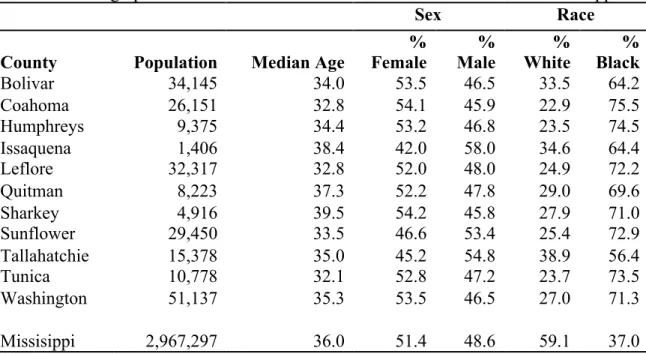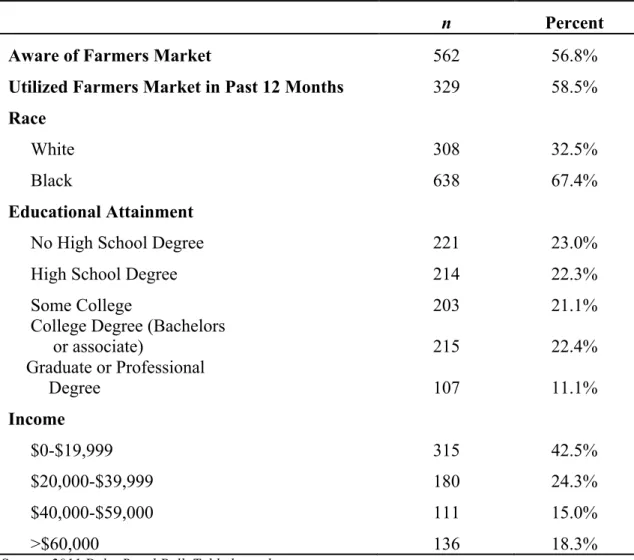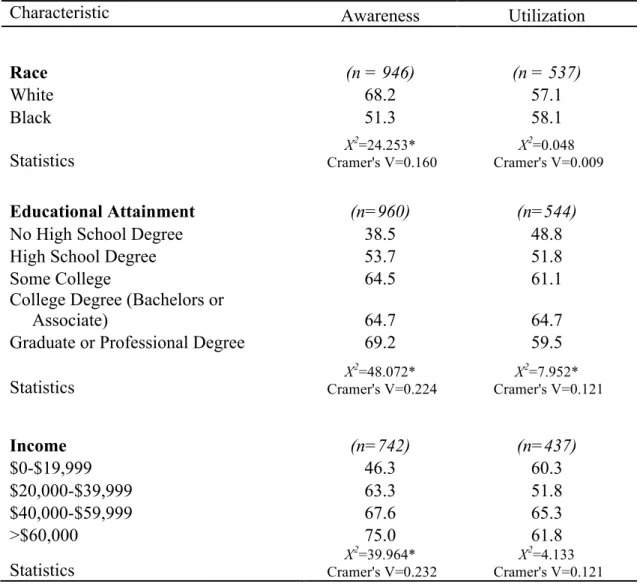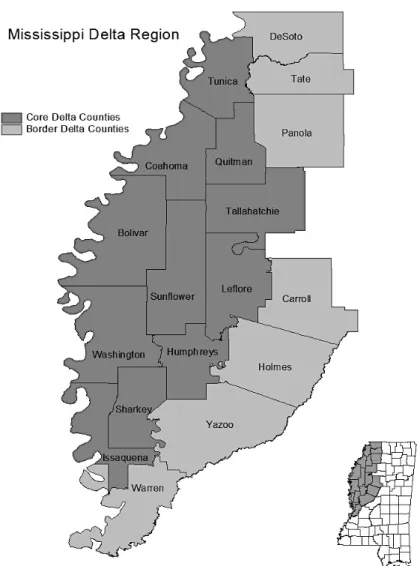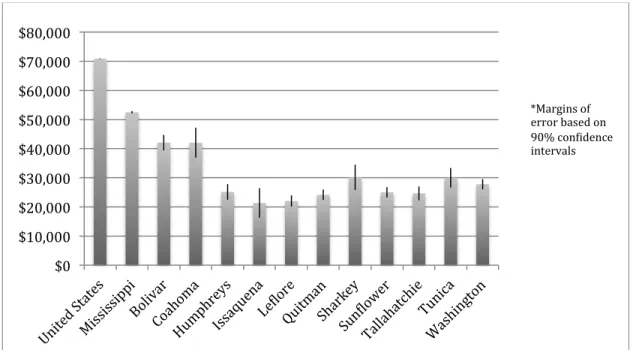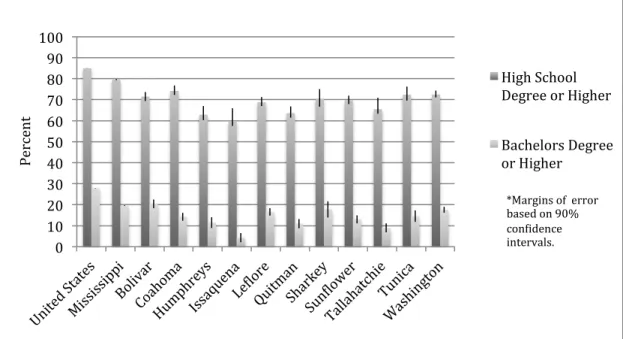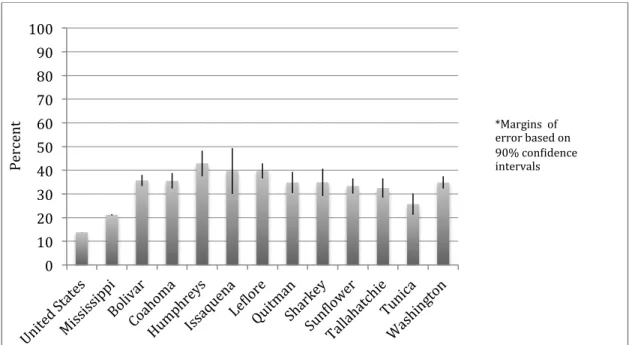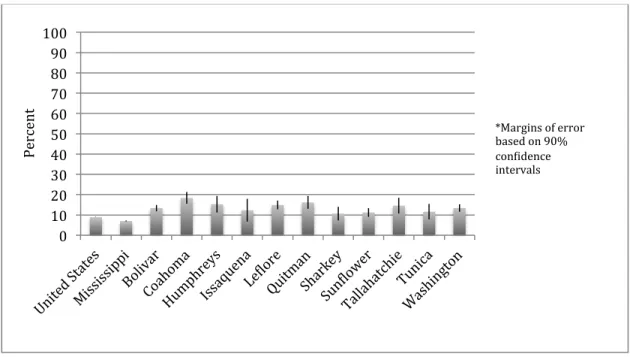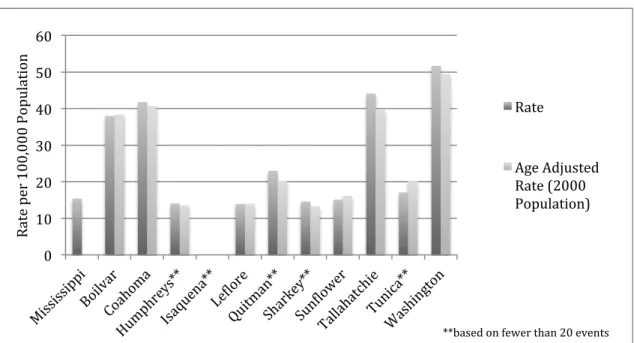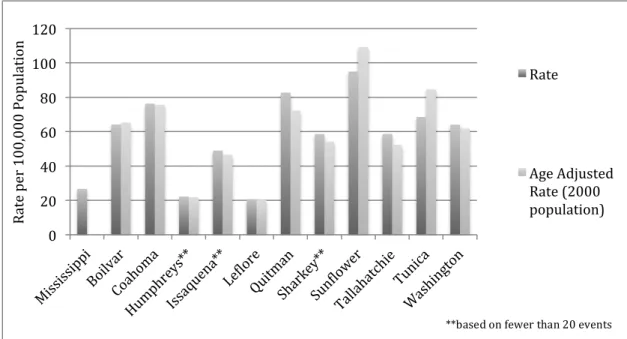FARMERS MARKETS AND FOOD SECURITY:
A CRITICAL EVALUATION OF THE SOCIODEMOGRAPHIC FACTORS INFLUENCING MARKET PATRONAGE IN THE MISSISSIPPI DELTA
by
Mary Margaret Saulters
A thesis submitted to the faculty of The University of Mississippi in partial fulfillment of the requirements of the Sally McDonnell Barksdale Honors College.
Oxford May 2013
© 2013
Mary Margaret Saulters ALL RIGHTS RESERVED
ACKNOWLEDGEMENTS
To Jim and Sally Barksdale and the Sally McDonnell Barksdale Honors College, thank you for providing me with the opportunity and resources to conduct exploratory research and to write a thesis as an undergraduate.
To Dr. John Green, thank you for serving as my advisor for this project and for your continued support and guidance over the past year. During our first meeting, you helped me develop a research question from my broader interests. Since then, through your wise counsel and generous provision of resources, you have added depth and meaning to this project. You have guided me when I needed direction and empowered me when I needed to forge my own way. Through your unabashed enthusiasm for sociology and community development, you have welcomed me into the world of academic research. Dr. Green, you have challenged, encouraged, and inspired me as an advisor, a mentor, and a friend. Thank you.
To Beth Foose, thank you for teaching me to find classrooms in gardens, to follow the wild geese, and to “hold on to my carrots” when things get hard. As a mother and a teacher, you have always inspired creativity and critical thinking. It was your passion for justice that led me to begin looking at food security in the Delta, and your uncompromising determination that inspired me to complete this project. For everything, thank you. And to Hannah Saulters, thank you for editing and proofreading multiple drafts of this thesis, for always knowing what to say, and for providing soundtracks for my many drives to the Delta.
I would also like to thank Dr. Debra Young and Dr. Albert Nylander for offering their time and invaluable feedback as readers on my thesis committee. I would like to thank everyone at the Center for Population Studies for their support throughout this project. I would like to thank David and Barbara Arnold for introducing me to the Honors College and the Ole Miss community and encouraging me to always strive for excellence. Finally, I would like to thank Michael Foose and Robert Saulters for their patience and unconditional love.
ABSTRACT
MARY MARGARET SAULTERS: Farmers Markets and Food Security:
A Critical Evaluation of the Sociodemographic Factors Influencing Market Patronage in the Mississippi Delta
(Under the direction of John Green, Ph.D.
Associate Professor of Sociology;
Director, Center for Population Studies)
Characterized by extreme poverty, limited access to fresh foods, and a high prevalence of nutrition-related disease, the rural Mississippi Delta represents an understudied and highly at-risk population in terms of food security. This paper explores the role of alternative foodways in the Delta, specifically examining the potential for farmers markets to improve community food security in rural, low- income areas. This study uses a mixed-methods approach to measure farmers market patronage among different racial and socioeconomic groups in the Mississippi Delta. The findings of this study indicate that while sociodemographic factors, such as race, income, and education are associated with consumers’
awareness of farmers markets, the strength of the association between these factors and utilization of
farmers markets is much lower. These findings illustrate that the factors influencing farmers market patronage are more complex than the existing literature suggests. In addition, this study demonstrates the importance of farmers market outreach and social marketing efforts in improving market accessibility for marginalized groups.
TABLE OF CONTENTS
ABSTRACT ... IV LIST OF TABLES AND FIGURES ... VI
INTRODUCTION ... 1
LITERATURE REVIEW ... 5
POTENTIAL BENEFITS OF FARMERS MARKETS ... 5
CHALLENGES FOR IMPROVING ACCESSIBILITY OF FARMERS MARKETS ... 8
SOCIODEMOGRAPHIC PROFILES OF FARMERS MARKET SHOPPERS ... 12
RECOMMENDATIONS FOR IMPROVING ACCESSIBILITY OF FARMERS MARKETS ... 13
HYPOTHESES ... 15
RESEARCH METHODS ... 16
SOCIODEMOGRAPHIC PROFILES ... 17
DELTA RURAL POLL AND STATISTICAL ANALYSIS ... 17
FINDINGS ... 20
SOCIODEMOGRAPHIC PROFILE OF THE MISSISSIPPI DELTA ... 20
A PORTRAIT OF A DELTA MARKET ... 21
DELTA RURAL POLL FINDINGS ... 23
MOVING FORWARD ... 24
DISCUSSION ... 27
LIST OF REFERENCES ... 29
APPENDIX ... 34
LIST OF TABLES AND FIGURES
Table 1 Demographic Characteristics of Eleven Core Delta Counties and
Mississippi………...35 Table 2 Descriptive Statistics from the Delta Rural Poll………36 Table 3 Farmers Market Patronage of Delta Rural Poll Respondents by
Sociodemographic Factors………...37 Figure 1 Map of the Core Delta Region of Mississippi………...38 Figure 2 Educational Attainment among Residents of Delta Counties,
Mississippi, and the United States (2006-2010)………...39 Figure 3 Median Household Income among Residents of Delta Counties,
Mississippi, and the United States (2006-2010)………....39 Figure 4 Percent of Population below the Poverty Level in Delta Counties,
Mississippi, and the United States (2006-2010)………...40 Figure 5 Percent of Households without Access to a Vehicle in Delta Counties,
Mississippi, and the United States (2006-2010)………40 Figure 6a Death Rates for Diabetes Mellitus in Delta Counties and Mississippi
(2006-2010) per 100,000 Population……….41 Figure 6b Death Rates for Hypertension in Delta Counties and Mississippi
(2006-2010) per 100,000 Population………...41 Figure 6c Death Rates for Heart Disease in Delta Counties and Mississippi
(2006-2010) per 100,000 Population………...42 Figure 7 Farmers Market Awareness and Utilization by Race………...42 Figure 8 Farmers Market Awareness and Utilization by Educational
Attainment……….43 Figure 9 Farmers Market Awareness and Utilization by Household Income
Level………..43 Figure 10 Farmers Market Awareness and Utilization by Delta County…………...44
INTRODUCTION
As defined by the World Food Summit in 1996, food security is a condition existing when “all people, at all times, have physical, social, and economic access to sufficient, safe and nutritious food that meets their dietary needs and food preferences for an active and healthy life” (FAO 1996). Food insecurity, on the other hand, results when there is limited or uncertain availability of safe or nutritious food. Areas characterized by this limited access to affordable and nutritious food are referred to as food deserts. In a 1993 report on World Hunger, Peter Uvin names three components of food insecurity:
shortage, poverty, and deprivation. Food shortage focuses on an area’s food supply, specifically how much food is being produced, where the food is available for purchase, and whether or not there is sufficient food to meet the needs of that area’s population.
Food poverty is the inability of households to obtain food due to “inadequate income, poor access to productive resources, inability to benefit from private or public food transfers, or lack of other entitlements to food” (Uvin 1993: 9). While food poverty certainly refers to a household’s economic capacity to purchase food, it also addresses the broader structural inequalities that prevent certain racial or socioeconomic groups from accessing food. Finally, food deprivation deals with the nutritional value of the food that is available in an area and is linked to problems such as malnutrition and undernutrition.
As Uvin observes, the relationships among these three concepts are quite complex.
Studies of food security, therefore, should look critically at these three elements, the ways
in which they are related, and how they might manifest differently in a variety of community contexts.
Food security can be measured at a number of levels: individual, household, community, region, state, and nation. This study focuses specifically on community food security, a situation in which “all community residents obtain a safe, culturally
acceptable, nutritionally adequate diet through a sustainable food system that maximizes community self-reliance and social justice” (Hamm and Bellows 2003: 37). The concept of community food security is unique from other levels of food security in its
incorporation of “(a) an emphasis on human, economic, and social rights, (b) community empowerment and self-reliance (as opposed to self-sufficiency), and (c) a systemic understanding of sustainable natural resource use within a food system context” (Hamm and Bellows 2003: 38). In other words, community food security focuses on the
community food system as a whole rather than solely the individuals or households within that community. As such, efforts that seek to address community food insecurity must look at a wide range of problems through a systems approach, integrating seemingly disparate social and economic factors to inform effective community-based solutions (Winne 2008).
One creative approach for alleviating each of the three elements of community food insecurity is the establishment of famers markets – market outlets where farmers bring their produce for sale directly to consumers – in food insecure areas. By providing an outlet for farmers to sell local produce directly to consumers, farmers markets offer the potential for contributing to local economic development, promoting sustainability,
improving community health, promoting access to fresh food, and alleviating food insecurity.
Since 2000, the number of registered farmers markets in the United States has increased from 2,863 to 7,864 (US Department of Agriculture 2012). This growing popularity of farmers markets is linked to a broader social movement aimed at shifting the choices consumers make about food. Characterized by a resistance to the dominant agrifood system, the so-called alternative food movement works to raise awareness about the social and environmental consequences of our food choices and encourages shoppers to choose local and organic products rather than processed and industrially produced foods that are often shipped over long distances (Alkon and Agyeman 2011). Farmers markets, as well as other alternative food initiatives such as community-supported agriculture, farm-to-school initiatives, and community gardens have proliferated as a result of the food movement.
Although the alternative agrifood movement promotes positive economic, environmental, and social changes, disparities persist among racial and spatial groups in terms of the accessibility of some of these alternative agrifood institutions. Ironically, the communities that are “disproportionately harmed by the current food system,” are often excluded from the food movement narrative as well (Alkon and Agyeman 2011). Within the dominant food system, poor communities and communities of color are
disproportionately denied access to fresh, healthy food because of high prices, limited transportation, and inconvenient store locations. Similar barriers prevent these groups from accessing alternative agrifood institutions such as farmers markets (Colasanti, Conner, and Smalley 2010). In addition, a predominately white and middle-class
discourse dominates the food movement, further isolating certain socioeconomic groups (Alkon and McCullen 2011). In order for farmers markets to reach their full potential for improving food security among rural communities, these inequalities must be addressed.
As a growing number of scholars explore issues related to alternative foodways in rural settings (Andreatta and Wickliffe 2002, Gasteyer et al. 2008, Schmit and Gomez 2011), there is a particular need for “local research that can provide a basis for the sound planning and expansion of [food justice] projects” (Markowitz 2010). This study, which employs a mixed-methods approach, includes a review of the literature on farmers markets and food security, a sociodemographic profile of the Mississippi Delta region, observational site visits to the Delta, key-informant interviews with farmers market organizers, and an analysis of secondary data from a poll given to Delta residents to evaluate their awareness and utilization of farmers markets in this region. The findings of this study contribute not only to the growing body of academic research aimed at understanding and improving local food justice projects, but can also serve as a resource for community planners and market organizers interested in increasing the accessibility of markets to traditionally marginalized groups.
LITERATURE REVIEW
The studies included in this review were selected primarily for their common focus on farmers markets as part of the broader alternative agrifood movement.
Particular attention was given to those studies that examined farmers markets in rural and low-income communities and those that explored the opportunities and challenges of these markets for improving community food security. Much of the existing literature surrounding the current food system focuses more on identifying problems with the dominant industrial system than on the work being done to solve these problems
(Kloppenberg, Hendrickson, and Stevenson 1996), leaving alternative agrifood systems such as farmers markets and community supported agriculture (CSA) largely unstudied.
However, a growing number of scholars are turning their attention to these institutions, using the food system as a lens through which to examine broader questions of
sustainability, social justice, public health, and community viability. By highlighting some of these studies, this review provides insight into the innovative work that is being done on the sociology of food and farmers markets and illustrates areas where more research needs to be done.
Potential Benefits of Farmers Markets
The existing literature demonstrates that farmers markets hold potential benefits for both farmers and consumers. As Schmit and Gómez argue, direct marketing channels,
such as farmers markets, “allow farmers more control over their distribution and marketing activities relative to wholesale or commodity channels, while they offer an alternative outlet for consumers to seek local, fresh products directly from the source”
(2010: 119). Within the literature, studies explore the potential benefits of farmers markets through a range of lenses, including farmers’ experiences selling at markets (Griffin and Frongillo 2003), consumers’ motivations for purchasing food at markets (Andreatta and Wickliffe 2002), and the social and market interactions among vendors and customers at farmers markets (Baber and Frongillo 2003). Findings from these studies demonstrate that farmers enjoy working with the public at farmers markets (Andreatta and Wickliffe 2002), that vendors and consumers value both the market and non-market transactions associated with market shopping (Baber and Frongillo 2003), and that individuals with access to farmers markets “enjoy shopping there and think it is socially beneficial to do so” (Brown 2002).
Findings also highlight the value of farmers markets in improving community public health. Although a number of studies have linked regular fruit and vegetable consumption with a lower risk for heart disease, cancer, and a number of other diseases (Van Duyn and Pivonka 2000), fewer than three percent of men and six percent of
women between the ages of 19 and 50 consume the recommended daily servings of fruits and vegetables (Guenther et al. 2006). This statistic is even lower among low-income populations (Kamphuis et al. 2006). The literature recognizes the potential for farmers markets to improve public health by “increase[ing] community-wide fruit and vegetable consumption, particularly via improving fruit and vegetable availability in low-income
neighborhoods with poor access to healthful foods” (Larson, Story, and Nelson 2009;
McCormack et al. 2010).
Farmers markets also serve as an outlet for community and economic development. Gillespie et al. (2007) highlight a number of the potential benefits of farmers markets by examining the ways in which farmers markets can serve as
“keystones” in rebuilding local and regional food systems. By bringing together
seemingly separate social and economic elements such as “the local resource bases and skills of producers, the needs and preferences of local households, and the development goals of communities,” farmers markets are unique outlets for community development (Gillespie et al. 2007: 48). As Gillespie et al. explain, farmers markets promote local food system revitalization through four interrelated processes: “(1) making local food products and producers regularly visible in public settings, (2) encouraging and enabling producer enterprise diversification, (3) incubating small businesses, and (4) creating environments where market transactions and nonmarket social interactions are joined”
(2007: 48).
As Gillespie et al. (2007) note, farmers markets are generally housed in highly trafficked public spaces, and so their presence serves to raise awareness that locally produced foods are available in the area and might encourage community members to purchase their food from outlets outside the industrial agrifood system. Farmers markets can also act as a means for promoting diversification of local food systems by enhancing the “economic viability of small agricultural and food businesses while also developing consumer demand for local food” (Gillespie et al. 2007: 53). In other words, selling at an outlet that does not subsidize monoculture but rather encourages diversity allows farmers
to take advantage of longer growing seasons, reduces the risk of production failures and market price fluctuations, and provides a venue for farmers to sell products that they might not be able to sell conventionally. Having a diverse selection of seasonal produce at markets also builds consumer demand for local foods as customers become aware of the variety of products available at markets (Gillespie et al. 2007). According to Gillespie and colleagues, the third process identifies the role of farmers markets in developing small businesses. This has been studied in depth by Hinrichs, who argues that the interactions among vendors and consumers at farmers markets promote
entrepreneurship among the vendors by allowing them to discuss their products and their marketing strategies (Hinrichs, Gillespie, and Feenstra 2004). This “human connection”
is not present for those shopping at superstores or for farmers selling through
conventional commodity markets (Hinrichs 2000: 295). The fourth and final process identified by Gillespie et al. follows the idea set forth in the third process – the role of the farmers market as a social space. The social connections formed at farmers markets are critical in addressing community food insecurity; for example, a study by Morton et al.
(2005) found that individuals rely on personal interactions to solve food insecurity issues.
In other words, because they serve as a space for community members to meet, converse, and exchange ideas, farmers markets are different from other commercial food outlets in their capacity to build community around food.
Challenges for Improving Accessibility of Farmers Markets
Despite the potential benefits of farmers markets and the growing evidence that low-income consumers desire healthier and more sustainable food options (Dowler
2008), there are a number of structural, spatial, and racial disparities that make it difficult to establish viable farmers markets in low-income and rural areas. While farmers markets are often lauded for their potential to be “win-win economic solutions for both small- scale farmers and low-income consumers,” market managers report that they face the challenge of accomplishing dichotomous goals of ensuring fair prices for vendors and providing affordable products for food insecure consumers (Guthman, Morris, and Allen 2006: 662). Direct markets such as farmers markets and CSAs are important outlets for farmers to diversify their income, because they are one of the few spaces where growers can get retail prices for their goods without paying a middleman. This has been a long recognized benefit of farmers markets (Andreatta and Wickliffe 2002; Govindasamy, Italia, and Adelaja 2002). However, as farmers markets strive toward the goal of improving food security, market managers struggle with balancing the needs of their vendors with those of their customers.
Although the prices at farmers markets are typically congruent with grocery store prices (Flamm 2011), farmers markets are less likely than other commercial food outlets to accept food stamps or other government subsidized food vouchers, making the food at farmers markets less accessible to low-income consumers. This disparity highlights the importance of subsidies directed specifically at farmers markets, in the form of federal food assistance programs or grants from private institutions, to establish “market infrastructure and mak[e] products affordable for low-income consumers” (Markowitz 2010: 76). Unfortunately though, the current government funded food assistance
programs are somewhat limited in their ability to promote farmers market patronage. One 1999 study found that food stamp redemptions at farmers markets accounted for
approximately 0.02 percent of all food stamp redemption (Kantor 2001: 22), and between 1994 and 1998, food stamp redemptions at farmers markets fell from $6.4 million to $3.8 million. Much of this decline can be attributed to the implementation of Electronic Benefits Transfer (EBT), which requires that an individual’s government benefits be deposited onto a payment card. Because EBT card readers require both electricity and a phone line, this transition from paper vouchers has made it much more difficult for farmers markets to accept food stamps (Guthman, Morris, and Allen 2006). Although a number of federally funded voucher programs have emerged to increase the use of
farmers markets, including the Farmers Market Nutrition Program (FMNP) of the Special Supplemental Nutrition Program for Women, Infants and Children (WIC) and the Senior Farmers Market Nutrition Program (SFMNP), these programs are limited by both season and amount. As Guthman et al. (2006) report, FMNP vouchers are typically valued at
$10 to $20 per individual per year and are distributed only between the months of May and November. Even among those markets that do accept EBT and FMNP, a lack of awareness among consumers about these payment options has prevented higher utilization of these programs (Flamm 2011).
In addition to the question of affordability, location and transportation are also barriers that limit the accessibility of farmers markets in some low-income communities.
A number of studies found that inconvenient location and hours of operation were among the most frequently cited reasons for not attending farmers markets (Govindasamy, Italia, and Adelaja 2002; Eastwood, Brooker, and Gray 1999). In addition, limited public transportation and low vehicle ownership rates in rural areas prevent many customers from accessing supermarkets or farmers markets, hence these shoppers often depend on
“high-priced corner stores with a poor selection of healthy foods” (Fisher 1999: 6). Also, low-income individuals often work multiple jobs, creating time constraints that impede their ability to shop at farmers markets (Fisher 1999).
Finally, much of the alternative agrifood movement is informed by a
predominately white discourse (Alkon and McCullen 2011). Because the planning of many markets reflects whitened cultural practices and desires, some markets “lack resonance in the communities in which they are located” (Guthman 2008: 431). In her 2008 study, Guthman explores the subjects of alternative agrifood practices, finding that within this movement, there is an incredible “disjunction between what alternative food activists do and what food desert residents seem to want” (Guthman 2008: 443). A number of other scholars have explored this issue, including Alkon and Agyeman, who argue that the narrative of the alternative agrifood movement “consists of a group of like- minded people, with similar backgrounds, values, and proclivities, who have come to similar conclusions about how our food system should change” (2011: 2). Connecting this argument to the broader theme of equitable food distribution in their book, Food Justice, Alkon and Agyeman explain that participants in the alternative agrifood
movement tend to have “the wealth necessary to participate in its dominant social change strategy – the purchase of local organic food – or at least the cultural cachet necessary to obtain such foods” (2011: 3). On the other hand, those who stand to benefit the most from the alternative agrifood movement are often excluded. Finally, Slocum explores the ways in which “whiteness” is embedded in spatial dimensions of food politics, arguing that the
“whiteness” of this movement is the product of white ideas of healthy food and healthy bodies being used to inform community food projects (2006). As Slocum (2010)
observes, this dynamic should be considered by those studying food, as it highlights the ways in which our food system is embedded in circulations of power and race. Allen (2004) echoes this sentiment, arguing that certain perceptions of local food systems can mask imbalances in power that result from ethnic, class, and gender divisions and are embodied in local food systems.
Sociodemographic Profiles of Farmers Market Shoppers
A number of studies have been conducted in recent years with the goal of gaining insight into the sociodemographic factors associated with farmers market patronage. As Brown observed in her 2002 review of farmers market literature, “the identification of patrons and potential patrons is important to farmers, market organizers and sponsoring agencies” (2002: 169). In addition, surveys of market consumers serve to highlight socioeconomic and racial disparities in accessing farmers markets. In his evaluation of Tennessee markets, Eastwood et al. note that the typical fresh produce shopper is “a white female who is over 45 years old, has at least been to college, and is in an above average income group” (1999: 70). He found that this profile was consistent with
shoppers at nearby farmers markets. Much of the literature supports this generalization.
For example, a study of consumer trends at New Jersey markets found that 62% of market shoppers had graduated from college, 84% were Caucasian, and 79% reported household incomes of $40,000 or more (Govindasamy, Italia, and Adelaja 2002). A profile of the consumers at the San Louis Obispo County Market in California reveals similar trends, with 82% percent of respondents having completed some college and 65%
earning more than $40,000 per year (Wolf et al. 2005). In a study of Alabama farmers
market consumers, 60% were found to have a high school education and 90% had a household income exceeding $25,000; however, the racial divide was less apparent, with whites representing 49% of market customers (Onianwa, Mojica, and Wheelock 2006).
Studies have also been conducted to evaluate why individuals choose to shop at farmers markets. The goal of Zepeda’s 2009 study, for example, was to determine whether or not differences exist among those who shop at farmers markets and those who do not in terms of not only their demographics but also their motivations for shopping at farmers markets. Among the most commonly cited reasons for attending farmers markets are a commitment to purchasing fresh and nutritious food from local farmers and a
concern for the environment (Andreatta and Wickliffe 2002; Zepeda 2009; Wolf et al.
2005).
Recommendations for Improving Accessibility of Farmers Markets
In response to the apparent disparities in the accessibility of some farmers markets to certain racial and socioeconomic groups, a number of studies offer recommendations for how farmers markets might better address community food insecurity. Across the literature, there is consensus that low-income markets need to be subsidized. As Fisher (1999) notes, one subsidy may be FMNP vouchers. These subsidies are critical for establishing market infrastructure and improving market accessibility. Among those markets that are able to accept FMNP and EBT, efforts should be made to increase awareness of these programs to low-income consumers. As Dollahite et al. observe, FMNP “offers low-income communities increased access to fresh produce, reinforces the
and skill development in selecting, preparing, and storing fresh produce” (2005: 340).
However, unless consumers are aware of farmers markets and their participation in FMNP and EBT, these goals cannot be accomplished. Eastwood et al. (1999) offer several suggestions for increasing awareness of farmers markets, including advertising via newspapers and roadside signs as well as handing out recipe cards with a map to the farmers market at local offices where at-risk clientele are served. Other studies stress the importance of community ownership of markets if they are to be viable community resources. For example, Markowitz notes, “public participation and decision-making power are central to the creation of new spaces of local food system projects” (2010: 71).
Regardless of the approach for improving the viability of markets in low-income or rural areas, Gasteyer et al (2008) argue that because no two markets are the same, one cannot use a “one-size-fits-all” approach. Hence, localized, community-based research is critical for informing creative and effective solutions tailored to each market’s needs.
Across the literature, an increasing amount of attention has been given to alternative foodways such as farmers markets as well as the social impacts of these institutions. However, the existing literature is somewhat limited in terms of both geography and scope. Most of the current studies of farmers markets and food security focus on markets in urban areas, and those that do look at rural areas take place
predominantly on the West Coast and in New England. Further research is needed to understand the role of farmers markets in the rural South and the potential that these markets have to improve food security in the growing food deserts of the Southeastern United States. In addition, more studies of farmers markets are needed that, like Gillespie et al. (2007) look at farmers markets and other alternative agrifood institutions as they fit
into local social and economic contexts as well as the broader agrifood system. Finally, additional community-based research is needed that addresses not only the challenges of establishing farmers markets in low-income areas but begins to propose solutions for how to establish effective markets in these areas.
HYPOTHESES
Based on the findings of the literature review, it was hypothesized that among Mississippi Delta residents, there would be an association between farmers market awareness and utilization and respondents’ (a) race, (b) educational attainment, and (c) income level.
RESEARCH METHODS
The research for this project took place between June and December, 2012.
Conducted as part of an internship for the Center for Population Studies at the University of Mississippi, this project employed a mixed-methods approach, combining secondary data analysis with field observations and key-informant interviews in order to evaluate the awareness and utilization of farmers markets among different socioeconomic groups in the Mississippi Delta. During the summer of 2012, a number of field visits were made to Bolivar and Coahoma counties to observe farmers markets and local food conditions in Delta communities and to assess the challenges and opportunities for increasing access to fresh food in this region. The Cleveland Farmers Market, located in Bolivar County, served as an illustrative case study of a successful small town market attempting to better serve low-income consumers. Three field visits were made to the Cleveland Market for observation. The market operates on Saturday mornings and Thursday afternoons
throughout the spring and summer. Two field visits were also made to the nearby town of Mound Bayou, from which many farmers commute to the Cleveland Market. In addition, key-informant interviews were conducted with two market organizers and others
involved in local food systems in the Delta. The questions asked during these interviews were designed to reveal local perceptions of fresh food availability. Additionally,
documents, such as evaluation reports and marketing materials from the market were reviewed. This research process was approved through the University of Mississippi Institutional Review Board.
Sociodemographic Profiles
Data from the United States Census Bureau and the Mississippi State Department of Health were obtained to build demographic profiles for the eleven counties in this region. Data from the 2010 Decennial Census were used to measure age, sex, and population, while five-year estimates from the 2006-2010 American Community Survey (ACS) were used to measure educational attainment, access to transportation, median household income, and the percent of households below the poverty level. For each of these factors, the county data were contrasted to state and national estimates. ACS data are based on samples and have corresponding margins of error, so the 90% confidence intervals were included in the analyses. Finally, the State Department of Health’s Vital Records were used to estimate the prevalence of nutrition-linked diseases at the county and state levels.
Delta Rural Poll and Statistical Analysis
In order to explore awareness and utilization of farmers markets as well as the socioeconomic and racial disparities around accessing farmers markets, data from the 2011 Delta Rural Poll were analyzed. The Delta Rural Poll is a collaborative project between the Center for Community and Economic Development at Delta State University and the Social Science Research Center at Mississippi State University. The purpose of the Delta Rural Poll is to coordinate the collection of sociodemographic data on residents of the Mississippi Delta to be used in research as well as community planning and policy implementation. Administered biennially from 2003 to 2011, the poll is a simple random telephone survey of adults, aged eighteen or older, in the eleven Core Delta counties.
Poll participants are selected using a random digit dialing procedure. Since the survey was conducted by telephone, only individuals who lived in households with landline telephones had a chance of being interviewed. For the 2011 survey, 1,008 interviews were conducted. The cooperation rate was 77.2% and the overall response rate was 68.8%.
The Poll consists of a core of questions on demographics and quality of life as well as topical questions that vary with each survey. In 2011, participants were asked the following two questions related to awareness and utilization of farmers markets: (1) Are you aware of any farmers markets in your area where growers sell their locally produced fresh fruits and vegetables, and (2), If yes, did you purchase food at a farmers market in your area within the past 12 months? A positive response to the first question indicated farmers market awareness, while a positive response to the second question, which was only asked to those respondents who answered yes to the first question, indicated utilization of farmers markets.
The responses to these questions were then analyzed using IBM’s Statistical Package for the Social Sciences software to evaluate which racial and socioeconomic factors, if any, influence farmers market patronage in low-income communities. Cross tabulations were created for farmers market awareness and utilization with respondents’
race, educational attainment, and household income level in order to investigate the bivariate association between these factors and farmers market awareness and utilization.
Awareness and utilization were also measured geographically by comparing responses across the eleven counties. A series of statistical analyses were then conducted to evaluate the relationships between the racial and socioeconomic factors and farmers
market awareness and utilization. Cramér’s V was used to measure the strength of the associations among these factors. Cramér’s V ranges from 0 to 1, with higher scores representing a stronger association between variables. Pearson’s chi-square test was used to test for statistical significance. A significance level (alpha) of 0.05 was assumed for the chi-square analysis. The sample from the Delta Rural Poll was weighted to be
representative of state residents in terms of sex, race, and county location. The analyses were performed on both weighted and unweighted data, and only small differences were found. For clarity, the unweighted data are reported in this study.
FINDINGS
Sociodemographic Profile of the Mississippi Delta
The geographic scope of this project encompasses the “Core Delta” region of Mississippi, which includes Bolivar, Coahoma, Humphreys, Issaquena, Leflore, Quitman, Sharkey, Sunflower, Tallahatchie, Tunica and Washington counties (Figure 1). These counties were selected because they represent the distinctive characteristics of the Mississippi Delta region. Residents of the Delta comprise a largely unstudied and highly at-risk population in terms of nutritional health and food security (Stuff et al. 2004).
Ironically, although it is home to some of the most fertile farmland in the country, this region is characterized by limited access to fresh food along with a high prevalence of poverty and nutrition-related chronic diseases such as diabetes and hypertension, relative to the rest of the state.
The Mississippi Delta is predominantly rural, with 2010 county populations ranging from 1,406 in Issaquena to 51,137 in Washington County. African Americans make up approximately 70% of the population compared to 37% for the state of Mississippi (Table 1). The percent of individuals 25 years and older in Delta counties with a high school diploma ranges from 59.7% (Issaquena) to 74.3% (Coahoma) compared to state and national figures of 79.6% and 85.0%, respectively. Furthermore, the percent of individuals with Bachelors degrees or higher ranges from 4.3% (Issaquena) to 20.4% (Bolivar) compared to a national estimate of 27.9% (Figure 2). From 2006 to
2010, median annual household income among Delta residents ranged from $21,000 to
$42,000, while the median household income for the United States was just above
$70,000 for the same period (Figure 3). Approximately 35% of Delta residents live below the federal poverty level (Figure 4), and in some counties, the percent of households without a vehicle is more than two times the national rate (Figure 5).
In addition, there is a high prevalence of nutrition-linked chronic disease in the Delta compared to the state as a whole. The death rates for diabetes, hypertension, and heart disease for Delta counties are compared to state levels in Figures 6a, 6b, and 6c, respectively. These comparisons illustrate startling discrepancies, particularly for
diabetes and hypertension, with rates for some counties tripling the state averages in both categories. Given its unique sociodemographic make-up and its high prevalence of food insecurity and poor nutritional health, the Delta is an ideal setting for studying issues of food justice.
A Portrait of a Delta Market
In recent years, a number of Delta communities have opened farmers markets, organized farm-to-school programs, and initiated nutrition programs to begin addressing food insecurity in this region. Nearly every Core Delta county has some type of farmers market, roadside stand or other outlet for direct produce sales. Now in its seventh year of operation, the Cleveland Farmers Market, located in Bolivar County, is among the more established markets in the region. Although it is home to Delta State University, one of the region’s two universities, Bolivar County is not exempt from the problems of poverty, food insecurity, and poor health that characterize the Delta. With a median household
income of approximately $42,000, nearly 36% of Bolivar County’s 34,145 residents live below the federal poverty level.
Although Cleveland does have a number of large grocery stores and
supermarkets, citizens joined with community partners to form a farmers market in hopes of providing more fresh and affordable options for Cleveland residents and a sales outlet for small-scale producers in the area. The Cleveland market features fresh and locally grown produce as well as eggs, bread, and honey. A grassroots organization comprised of farmers and volunteers, the Cleveland Farmers Market works “(1) to create a fair market where local farmers, gardeners, and producers can sell directly to the public and (2) to develop [the] community by providing a weekly gathering space for social opportunities”
(Friends of the Cleveland Farmers Market 2012). The Center for Community and Economic Development, associated with the Division of Social Sciences and History at Delta State University, is also an important supporter of the market. In its first year of operation, the market consisted of four farmers from the nearby town of Mound Bayou who sold produce out of the backs of their trucks. In recent years, the market has grown to as many as sixteen vendors on some Saturdays.
The market has an incredibly supportive volunteer base, with community members serving as market managers, setting up tents and tables for vendors, and organizing marketing and outreach campaigns. As one market organizer remarked, “If you have a relationship with the people who are growing what you eat, you are more likely to eat that product.” This is the approach the market takes – forming relationships and thus building community around market participation – in addressing issues of food insecurity and poor nutritional health in the Delta. Despite these efforts, the market,
similar to others identified in the literature, has struggled to serve low-income and racially diverse consumers (Green 2008).
Delta Rural Poll Findings
The analysis of the Delta Rural Poll data gives context to the story of the Cleveland Farmers Market, illustrating the patterns of farmers market awareness and utilization in the region as a whole. Descriptive statistics from the Delta Rural Poll are summarized in Table 2, and the findings of the cross-tabulations and statistical analysis of the Delta Rural Poll data to test the hypotheses are summarized in Table 3. Among Delta Rural Poll respondents, 56.8% (Table 2) were aware of a farmers market in their area, but levels of awareness varied across sociodemographic groups. Awareness was found to be higher among white respondents (68.2%) than black respondents (51.3%) (Figure 7).
Also, awareness was higher among respondents with a college degree (64.5%) compared to respondents who had not completed high school (38.5%) (Figure 8). A similar pattern was seen for household income, with 75% awareness for those earning more than
$60,000 per year and 46% awareness for those earning less than $20,000 per year (Figure 9). The chi-square value exceeded the critical value for all three factors, indicating that the null hypotheses, that there would be no association between consumers’ awareness of farmers markets and their race, educational attainment, or income level, could be
rejected. The strength of the associations between farmers market awareness and these three factors – race, educational attainment, and household income - was measured using Cramer’s V, which is reported on a scale of 0 to 1. The associations between educational attainment and household income level (Cramer’s V = 0.224 and 0.232, respectively)
were found to be moderately associated with market awareness, while the association between race and awareness (Cramer’s V = 0.160) was weaker.
Market utilization, on the other hand, which was 58.5% (Table 2) for the region as a whole, did not vary significantly by race or socioeconomic category but did by
educational attainment (Table 3). Of those who were already aware of farmers markets, nearly the same frequency of black respondents (58.1%) and white respondents (57.1%) reported that they had purchased food at the farmers market in the past year. There was a weak but statistically significant (Cramer’s V = 0.121, X2 = 7.952) association between utilization and educational attainment. Utilization did not vary significantly by
household income category, with only a 1.5% difference between those earning less than
$20,000 per year and those earning more than $60,000 per year.
Moving Forward
When planning the Cleveland Farmers Market, organizers agreed that it should be as accessible as possible to low-income consumers. This commitment is reflected in the market’s original location1 and its acceptance of food assistance vouchers. One of the greatest strengths of the Cleveland market is its central location. On Saturday mornings, vendors gather in a grassy lot behind the local Post Office at the boundaries of
socioeconomically and racially diverse areas. Identified by Markowitz (2010) as a “fringe market,” this location attracts customers from a variety of Cleveland neighborhoods. In addition, the Cleveland market is one of only two markets in the Delta region that accepts Farmers Market Nutrition Program (FMNP) vouchers. However, upon implementing the
1 The location of the market has since changed, and the impact of this change will need to be monitored.
FMNP program, the Cleveland market faced a number of challenges. For example, the market initially saw low FMNP redemption rates, which they attributed to a number of factors, including too few producers, limited quantity and quality of produce, and
“confusion about how and where FMNP vouchers could be redeemed” (Green 2008). In response, market organizers created strategies to address four areas for improvement:
leadership development, networking, infrastructure improvements, and social marketing (Green 2008). As part of this initiative, market organizers hosted a number of marketing events throughout the Delta, recruited and trained a market manager, held listening sessions with WIC stakeholders, produced promotional market materials, and handed out recipe cards and samples to customers. As a result of these outreach programs, the market saw the average number of customers per week increase from 43 in 2006 and 2007 to 116 in 2008. Also, the number of registered vendors increased from 9 in 2006 to 16 in 2008 (Green 2008). Some of these efforts were undertaken with partial support from the Dreyfus Health Foundation and the U.S. Department of Agriculture’s Farmers Market Promotion Program. And, interestingly, the success of the Cleveland marketing efforts led to recognition of the importance of continued research and monitoring for the region as a whole, using tools such as the Delta Rural Poll.
The Cleveland Farmers Market joins a number of other efforts that have begun working for food justice in the Delta in recent years. For example, the Delta Fresh Foods Initiative (DFFI) is a diverse coalition of community stakeholders committed to
“establishing sustainable and equitable food systems in the Mississippi Delta” (Delta Fresh Foods 2012). Members of the DFFI include local farmers, consumers, activists, and health care professionals. Since its establishment in 2010, DFFI has undertaken a
number of projects, including the creation of region-wide farmers market alliance, the implementation of farm-to-school programs, and other initiatives to promote
sustainability in the Delta. Another organization working for sustainability is the Gaining Ground Sustainability Institute of Mississippi (GGSIM), whose mission is to establish a network for Mississippians to “learn about, connect with, and expand on sustainable practices” (Gaining Ground 2012). Also founded in 2010, GGSIM serves as a resource for farmers interested in adopting sustainable practices. While these initiatives are just a sample of the work being done on food systems in the Delta, they represent a shared desire to increase awareness about issues surrounding local foods and a commitment to alleviating food insecurity and achieving food justice in the Delta.
DISCUSSION
The findings from the Delta Rural Poll are consistent with the literature in that they demonstrate that there are socioeconomic disparities in accessing farmers markets.
However, analyzing awareness and utilization separately reveals that the ways in which sociodemographic factors influence the accessibility of farmers markets are much more complex than the current literature indicates. The findings of this study highlight the role that awareness plays in the success of farmers markets in a rural setting. While
fundamental racial and socioeconomic disparities were seen in awareness of local markets, these disparities were nearly undetectable in actual utilization of the markets.
This suggests that increasing awareness of markets among underrepresented groups will likely result in increased market patronage by those groups. These findings also indicate that lack of awareness should be considered among the principal barriers to the
accessibility of farmers markets to low-income consumers. The Delta Rural Poll findings are reflected in the case study of the Cleveland Farmers Market. After collaborative efforts were implemented to increase awareness among low-income consumers, the market saw a drastic increase in its customer base. While no two markets are the same, the Cleveland market’s outreach initiatives can serve as a model for markets in low- income communities seeking to improve the accessibility of their markets across racial and socioeconomic groups.
Given the importance of awareness in increasing farmers market patronage, these findings also illustrate the need for integrating farmers market outreach and marketing
their outreach efforts on the groups who are least aware of markets in their areas. By collaborating with community and government organizations who serve these
populations, farmers markets will hopefully be able to bring more people to the market and accomplish their broader goals of improving community food systems and food security. Also, as the Cleveland market demonstrates, government subsidies and grants are critical for establishing market infrastructure and allowing the market to dually benefit both vendors and low-income consumers. Hopefully, this research can serve as a resource for community organizers and market planners and as justification in grant proposals for increasing resources, specifically those for outreach programs.
Although questions of food systems and sustainability have only recently moved to the forefront of sociological exploration, this field contains “rich and rewarding possibilities for sociologists” (Hinrichs 2009: 7). Not only can sociologists provide insight into the motivations behind local food movements and the challenges and opportunities of these movements, but community-based research can serve to inform creative and effective solutions for real community change in terms of local food systems and sustainability. Specifically, additional community-based research and case studies of markets in low-income and rural communities are critical for the alleviation of food insecurity in these areas.
LIST OF REFERENCES
Alkon, Alison H. and Julian Agyeman, eds. 2011. Cultivating Food Justice: Race, Class, and Sustainability. Cambridge, MA: MIT, Print.
Alkon, Allison H. and Christie G. McCullen. 2011. “Whiteness and Farmers Markets:
Performances, Perpetuations…Contestations?” Antipode 43(4): 937-959.
Allen, Patricia. 2004. Together at the Table, Sustainability and Sustenance in the American Agrifood System University Park, PA: The Pennsylvania State University Press.
Andreatta, Susan and William Wickliffe, II. 2002. “Managing Farmer and Consumer Expectations: A Study of a North Carolina Farmers Market.” Human Organization 61(2): 167-176.
Baber, Laura M. and Edward A. Frongillo. 2003. “Family and Seller Interactions in Farmers’ Markets in Upstate New York.” American Journal of Alternative Agriculture 18: 87-94.
Brown, Allison. 2002. “Farmers Market Research 1940-2000: An Inventory and Review.” American Journal of Alternative Agriculture 17(4): 167-176
Colasanti, Kathryn J. A., David S. Conner and Susan B. Smalley. 2010.
“Understanding Barriers to Farmers’ Market Patronage in Michigan: Perspectives from Marginalized Populations.” Journal of Hunger and Environmental Nutrition 5: 316-338.
Delta Fresh Foods. 2012. “Delta Fresh Foods.” Retrieved July 2012 from http://deltafreshfoods.org.
Dollahite, Jamie S., Janet A. Nelson, Edward A Frongillo and Matthew R. Griffin.
2005. “Building Community Capacity through Enhanced Collaboration in the Farmers Market Nutrition Program.” Agriculture and Human Values 22: 339-354.
Dowler, Elizabeth. 2008. “Food and Health Inequalities: The Challenge for Sustaining Just Consumption.” Local Environment 13(8): 759-772.
Eastwood, David B., John R. Brooker and Morgan D. Gray. 1999. “Location and Other Market Attributes Affecting Farmer’s Market Patronage: The Case of Tennessee.” Journal of Food Distribution Research 30(1): 63-72.
FAO. 1996. “Definition of Food Insecurity.” United Nations Food and Agriculture Organization. Electronic. Accessed November, 2012. www.fao.org.
Fisher, Andy. 1999. “Hot Peppers and Parking Lot Peaches: Evaluating Farmers’
Markets in Low Income Communities.” Community Food Security Coalition, Venice, CA.
Flamm, Laura J. 2011. “Barriers to EBT Use at Farmers’ Markets: Lessons in Empowerment Evaluation from Rural Ohio.” Journal of Hunger and Environmental Nutrition 6: 54-63.
Friends of the Cleveland Farmers Market. 2012. “Cleveland Farmers Market.”
Retrieved July 2012 from http://clevelandfarmersmarket.blogspot.com.
Gaining Ground. 2012. “Gaining Ground Sustainability Institute of Mississippi.”
Retrieved July 2012 from http://www.ggsim.org.
Gasteyer, Stephen, Sarah A. Hultine, Leslie R. Cooperband and M. Patrick Curry.
2008. “Produce Sections, Town Squares, and Farm Stands: Comparing Local Food Systems in Community Contexts.” Southern Rural Sociology 23(1): 47-71.
Gillespie, G., D. Hilchey, C. Hinrichs, and G. Feenstra. 2007. “Farmers’ Markets as Keystones in Rebuilding Local and Regional Food Systems.” Pp. 47-65 in
Remaking the North American Food System, edited by C.C. Hinrichs and T.
Lyson. Lincon, NE: University of Nebraska Press.
Govindasamy, Ramu, John Italia and Adesoji Adelaja. 2002. “Farmers’ Markets:
Consumer Trends, Preferences, and Characteristics.” Journal of Extension 40(1).
Green, John. 2008. “Evaluation of the Cleveland Farmers Market and the WIC Farmers Market Nutrition Program.” Presentation given at the Second Annual MS Delta Farmers Market Networking Meeting.
Griffin, Matthew R. and Edward A. Frongillo. 2003. “Experiences and Perspectives of Farmers from Upstate New York Farmers’ Markets.” Agriculture and Human Values 20:189-203.
Guenther, P.M., K.W. Dodd, J. Reedy and S.M. Krebs-Smith. 2006. “Most Americans Eat Much Less than Recommended Amoungts of Fruits and Vegetables.” Journal of the American Dietetics Association 106: 1371-1379.
Guthman, Julie. 2008. “Bringing Good Food to Others: Investigating the Subjects of Alternative Food Practice.” Cultural Geographies 15: 431-447.
Guthman, Julie, Amy W. Morris and Patricia Allen. 2006. “Squaring Farm Security and Food Security in Two Types of Alternative Food Institutions.” Rural
Sociology 71(4): 662-684.
Hamm, Michael W. and Anne C. Bellows. 2003. “Community Food Security and Nutrition Educators.” Journal of Nutrition Education and Behavior 35(1): 37-43.
Hinrichs, C. Clare. 2000. “Embeddedness and Local Food Systems: Notes on Two Types of Direct Agricultural Markets.” Journal of Rural Studies 16: 295-303.
Hinrichs, C. Clare. 2009. “Sustainable Food Systems: Challenges of Social Justice and a Call to Sociologists.” Presentation given at the Annual Conference of the Pennsylvania Sociological Society, October 24, Shippensburg, PA.
Hinrichs, C. Clare, Gilbert W. Gillespie and Gail W. Feenstra. 2004. “Social Learning and Innovation at Retail Farmers’ Markets.” Rural Sociology 69(1): 31-58.
Kamphuis, Carlijn B.M. Katrina Giskes, Gert-Jan de Bruijn, Wanda Wendel-Vos, Johannes Brug, and Frank J. van Lenthe. 2006. “Environmental Determinants of Fruit and Vegetable Consumption among Adults: A Systematic Review.” British Journal of Nutrition 96: 620-635.
Kantor, Linda S. 2001. “Community Food Security Programs Improve Food Access.”
Food Review 24(1): 20-26.
Kloppenberg, J., J. Hendrickson, and G.W. Stevenson. 1996. “Coming into the Foodshed.” Agriculture and Human Values 13:33-42.
Larson, N.I., M.T. Story and M.C. Nelson. 2009. “Neighborhood Environments:
Disparitites in Access to Healthy Foods in the United States.” American Journal of Preventative Medicine 36: 74-81.
Markowitz, Lisa. 2010. “Expanding Access and Alternatives: Building Farmers’
Markets in Low-Income Communities.” Food and Foodways 18: 66-80.
McCormack, Lacey Arnenson, Melissa Nelson Laska, Nicole I. Larson and Mary Story. 2010. “Review of the Nutritional Implications of Farmers’ Markets and Community Gardens: A Call for Evaluation and Research Efforts.” Journal of the American Dietetic Association 110(3): 399-408.
Mississippi Department of Health. 2006-2010. Vital Records Statistics. Retrieved June, 2012 from http://mstahrs.msdh.ms.gov/.
Morton, Lois W., Ella A. Bitto, Mary Jane Oakland and Mary Sand. 2005. “Solving the Problems of Iowa Food Deserts: Food Insecurity and Civic Structure.” Rural Sociology 70(1): 94-112.
Onianwa, O., M. Mojica, and G. Wheelock. 2006. “Consumer Characteristics and Views Regarding Farmers Markets: An Examination of On-Site Survey Data of Alabama Consumers.” Journal of Food Distribution Research 37(1): 125-131.
Schmit, T.M., and M.I. Gomez. 2011. “Developing Viable Farmers Markets in Rural Communities: An investigation of Vendor Performance Using Objective and Subjective Valuations.” Food Policy 36: 119-127.
Slocum, Rachel. 2006. “Whiteness, Space, and Alternative Food Practice.” Geoforum 38: 520-533.
Slocum, Rachel. 2010. “Race in the Study of Food.” Progress in Human Geography 35(3): 303-327.
Stuff, Janice E., Jacqueline A. Horton, Margaret L. Bogle, Carol Connell, Donna Ryan, Sahar Zaghloul, Alma Thornton, Pippa Simpson, Jeff Gossett, and Kitty Szeto. 2004. “High Prevalence of Food Insecurity and Hunger in Households in the Rural Lower Mississippi Delta.” The Journal of Rural Health 20(2): 173-180.
U.S. Census Bureau. 2006-2010. American Community Survey Five-year Estimates.
Retrieved June, 2012 from http://factfinder2.census.gov/faces/nav/jsf/pages/index.
xhtml.
U.S. Census Bureau. 2010. Decennial Census. Retrieved June 2012, from http://factfinder2.census.gov/faces/nav/jsf/pages/index.xhtml.
U.S. Department of Agriculture. 2012. “Farmers Markets and Local Food Marketing.” U.S. Department of Agriculture Agricultural Marketing Service.
Electronic. Accessed September 2012. http://www.ams.usda.gov/
Uvin, Peter. 1993. “The State of World Hunger.” Pp. 1-42 in The Hunger Report:
1993, edited by Alan Shawn Feinstein World Hunger Program. Brown University.
Yverdon, Switzerland: Gordon and Breach Science Publishers.
Van Duyn, Mary Ann and Elizabeth Pivonka. 2000. “Overview f the Health Benefits of Fruit and Vegetable Consumption for the Dietetics Professional: Selected Literature.” Journal of the American Dietetics Association 100: 1511-1521.
Winne, Mark. 2008. Closing the Food Gap. Boston: Beacon Press.
Wolf,, Marianne McGarry, Arianne Spittler and James Ahern. 2005. “A Profile of Farmers’ Market Consumers and the Perceived Advantages of Produce Sold at Farmers’ Markets.” Journal of Food Distribution Research 36(1): 192-201.
Zepeda, Lydia. 2009. “Which Little Piggy Goes to Market? Characteristics of US Farmers’ Market Shoppers.” International Journal of Consumer Studies 33: 250- 257.
APPENDIX
Table 1. Demographic Characteristics of Eleven Core Delta Counties and Mississippi
Sex Race
County Population Median Age
% Female
% Male
% White
% Black
Bolivar 34,145 34.0 53.5 46.5 33.5 64.2
Coahoma 26,151 32.8 54.1 45.9 22.9 75.5
Humphreys 9,375 34.4 53.2 46.8 23.5 74.5
Issaquena 1,406 38.4 42.0 58.0 34.6 64.4
Leflore 32,317 32.8 52.0 48.0 24.9 72.2
Quitman 8,223 37.3 52.2 47.8 29.0 69.6
Sharkey 4,916 39.5 54.2 45.8 27.9 71.0
Sunflower 29,450 33.5 46.6 53.4 25.4 72.9
Tallahatchie 15,378 35.0 45.2 54.8 38.9 56.4
Tunica 10,778 32.1 52.8 47.2 23.7 73.5
Washington 51,137 35.3 53.5 46.5 27.0 71.3
Missisippi 2,967,297 36.0 51.4 48.6 59.1 37.0
Source: United States Census Bureau. 2010 Decennial Census. Table by author.
Table 2. Descriptive Statistics from the Delta Rural Poll
Source: 2011 Delta Rural Poll. Table by author.
n Percent
Aware of Farmers Market 562 56.8%
Utilized Farmers Market in Past 12 Months 329 58.5%
Race
White 308 32.5%
Black 638 67.4%
Educational Attainment
No High School Degree 221 23.0%
High School Degree 214 22.3%
Some College 203 21.1%
College Degree (Bachelors
or associate) 215 22.4%
Graduate or Professional
Degree 107 11.1%
Income
$0-$19,999 315 42.5%
$20,000-$39,999 180 24.3%
$40,000-$59,000 111 15.0%
>$60,000 136 18.3%
Table 3. Farmers Market Patronage of Delta Rural Poll Respondents by Sociodemographic Factors
*Significant at the p≤0.05 level.
Source: 2011 Delta Rural Poll. Table by author.
Characteristic Awareness Utilization
Race (n = 946) (n = 537)
White 68.2 57.1
Black 51.3 58.1
Statistics X
2=24.253*
Cramer's V=0.160
X2=0.048 Cramer's V=0.009
Educational Attainment (n=960) (n=544)
No High School Degree 38.5 48.8
High School Degree 53.7 51.8
Some College 64.5 61.1
College Degree (Bachelors or
Associate) 64.7 64.7
Graduate or Professional Degree 69.2 59.5
Statistics X
2=48.072*
Cramer's V=0.224
X2=7.952*
Cramer's V=0.121
Income (n=742) (n=437)
$0-$19,999 46.3 60.3
$20,000-$39,999 63.3 51.8
$40,000-$59,999 67.6 65.3
>$60,000 75.0 61.8
Statistics X
2=39.964*
Cramer's V=0.232
X2=4.133 Cramer's V=0.121
Figure 1. Map of the Core Delta Region of Mississippi
Source: Center for Population Studies, University of Mississippi.
Figure 2. Educational Attainment among Residents of Delta Counties, Mississippi, and the United States (2006-2010)
Source: United States Census Bureau. 2006-2010 American Community Survey. Figure by author.
Figure 3. Median Household Income among Residents of Delta Counties, Mississippi, and the United States (2006-2010)
Source: United States Census Bureau. 2006-2010 American Community Survey. Figure by author.
0 10 20 30 40 50 60 70 80 90 100
Percent
High School Degree or Higher
Bachelors Degree or Higher
*Margins of error based on 90%
conTidence intervals.
$0
$10,000
$20,000
$30,000
$40,000
$50,000
$60,000
$70,000
$80,000
*Margins of error based on 90% conTidence intervals
Figure 4. Percent of Population below the Poverty Level in Delta Counties, Mississippi, and the United States (2006-2010)
Source: United States Census Bureau. 2006-2010 American Community Survey. Figure by author.
Figure 5. Percent of Households without Access to a Vehicle in Delta Counties, Mississippi, and the United States (2006-2010)
Source: United States Census Bureau. 2006-2010 American Community Survey. Figure by author.
0 10 20 30 40 50 60 70 80 90 100
Percent *Margins of
error based on 90% conTidence intervals
0 10 20 30 40 50 60 70 80 90 100
Percent
*Margins of error based on 90%
conTidence intervals
